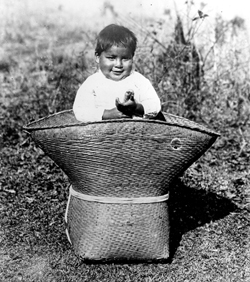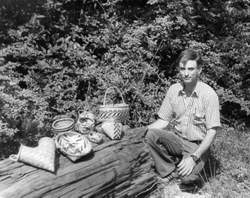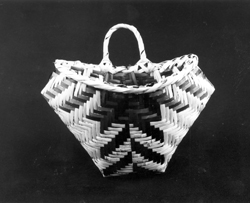Table of Contents
Folk Regions
Three Ethnic Perspectives
Folk Music of the Florida Parishes
People of the Florida Parishes
In Retrospect

Indians and Folklife in the Florida Parishes of Louisiana
By H. F. "Pete" Gregory
Throughout North America, the American Indian has been a powerful source of folk culture, and the Florida Parishes are no exception. What is notable about the area are the number, and kind, of Indian influences that did, and still do, affect it.
The most obvious Indian influence on the region is to be seen in the place names: Abita Springs, Amite River, Bogalusa, Boguefalaya, Manchac, Tangipahoa, Tchefuncte, and Tunica, to list only a few. Indian names are common in Louisiana, but somehow they seem to be especially concentrated between the Mississippi and Pearl River. The majority of these names can be traced to one of the Muskoghean languages: Acolapissa, Tangipahoa, Houma, or Choctaw proper. A few may reflect the influence of the Mobilian jargon, a language used in contact situations between whites, Indians, and Blacks. Tunica, a tribal name, was left by that tribe on the loessial hills where that tribe displaced the Houma in the 1600s. Eventually a red pole was raised on the bluffs to separate tribal territory, probably distinguishing the Houma from the Bayougoula to the southwest. This pole yielded the place names Istrouma (from the Choctaw for "red stick," isti huma), and the French version of that, Baton Rouge, the name of what is now the state capitol. From city streets and high schools to the names of bayous and creeks, the imprint of Native Americans on the region is apparent.
When Europeans first began to describe the tribes in the area where the Tunica had displaced the Houma, they had settled in the loess-capped hills along the Mississippi north of Tunica Bayou and Thompson Creek. The Houma shifted south in 1709 but retained control of their hunting grounds on the Amite River, crossing Lake Pontchartrain from their villages on the Mississippi River and upper Bayou Lafourche to hunt there.
According to the eighteenth century Ross Map, the Acolapissa had villages along the shore of Lake Pontchartrain. One was near New Orleans, but at least three others were shown between Pearl River and Lake Maurepas. The Tangipahoa ranged north, up the river that took their name.
These tribes were frequently targeted by colonial powers for political or military purposes. The Tunica grew wealthy from their role as middlemen in the salt and livestock trade with the Caddo and Latino populations in Texas and northwest Louisiana. They were also a mercenary tribe, serving first for the French in the Natchez war and later augmenting the Spanish troops under Bernardo de Galvez at the Battle of Baton Rouge.
Early in the eighteenth century, the French attempted to establish trade relations to the west, with Mexico, and moved the Natchitoches, a Caddoan-speaking tribe, to the Acolapissa north of Lake Pontchartrain. The two tribes gradually intermarried. When, in 1714, the French took the Natchitoches back to their old settlements in northwestern Louisiana, the Acolapissa reacted violently and killed some Natchitoches in retaliation.
From first contact, the Europeans in the Florida Parishes seem to have taken to the woods with the native peoples. Hunting and fishing are as integral to the lifestyle of Florida Parish folks as they were in the early eighteenth century. Gathering wild foods--dewberries (early May), wild strawberries (early May), and mayhaws--are still integral parts of the scenes in the Florida Parishes.

The Choctaw, closely allied to the French in their southern settlements, had considered the region their country since at least the 1720s. Their presence led to a close interaction with white Creoles in Mandeville, Bayou Lacombe, and even New Orleans proper. Creolist George Reinecke has noted that there was a special market where Choctaw from north of Lake Pontchartrain traded heavily when they came to the city. Early magazines, such as Harper's Weekly, illustrated Choctaw men and women selling their basketry and herbs at the French Market. Dressed partly in European garb, but also sporting beads, silver, and bright colors, they added an exotic touch to the market.
White Creole families had close ties across the Okwa Chitto, as Lake Pontchartrain was called by the Choctaw. Some, like Simon Favre, were part Choctaw themselves. Favre served as a Choctaw translator for the Spanish government, and today his family name is still found at Coushatta Choctaw community in Mississippi.
Creole families used Choctaw cane basketry for clothes hampers and storage containers. Various hanging baskets held cutlery and other objects, usually in the kitchen. The Creoles also integrated the Choctaw herbal lore into their cookery, especially filé, and frequently roamed the woods of Bonfouca with Choctaw peers. Cane blowguns, called sabracane, were often used by Creole families, and some have been handed down for generations. Choctaw and mixed-blood families still make them today. The Creoles also developed an affinity for Choctaw stickball. Not only did they attend the Indian games, but they formed their own teams (with streamlined, lighter ballsticks) and allowed their slaves to play on a field near Algiers. Raquette, as the Frenchmen called it, was one of the more popular Louisiana sports.
The French Creoles also incorporated the Choctaw into their literature, poetry, and paintings. In no other part of Louisiana are Indians so graphically depicted, sometimes with realism, often romantically.
As British Americans entered the region, the Creoles held them in great disrespect, and much of their own ethnocentrism was absorbed by their Choctaw neighbors and kinsmen. Certainly the gross mistreatment of Choctaws by Americans, as depicted in the writings of Dominique Rouquette, had something to do with the nature of Choctaw-Anglo interaction. The Choctaws had been killed, abused, and ridiculed by the Americans. However, the Creole planters wisely advised them not to retaliate, for fear the British Americans would annihilate the Indians completely. So, by the 1850s, Choctaws were living on the grounds of Creole plantations, protected in part by the patronage of wealthy planters. They hunted, traded, and sometimes were used to track down runaway slaves. Creole literature, especially such ante-bellum French novels as Dr. Alfred Mercier's Habitation de Saint-Ybars, offers realistic pictures of the Choctaw in such situations.
The Creoles also developed a culture hero in Adrian-Emmanuel Rouquette. Rouquette became a priest and moved among the Choctaw living north of Lake Pontchartrain. His Creole biographer, Dagmar LeBreton, noted he was called "Chata Ima," Choctaw-like, by the Indians. Rouquette collected a vocabulary and artifacts, wore his hair long and dressed "Indian style," according to Albert Gatschet, the linguist from the Smithsonian who met him in the 1880s. Chata Ima eventually entered into Northshore tradition. The mission to the Choctaws continued until 1925, the last priest being Father Francis Baley O.S.B. Some Choctaws objected to the education provided because it eroded the Choctaw language, according to Thomas Colvin.
John Peterson, based on the early descriptions of Cora Bremer, noted the Choctaw reticence to interact with whites at the turn of the century. Dominique Rouquette notes they held day-labor jobs in disdain, equating them with slavery. Both note they kept their traditions and managed to hold on to their language. Jobs cutting and rafting logs insulated them from "bosses," and allowed them to maximize their knowledge of the ecology.
Both Bremer and folklorist Andre Lafargue noted that the Choctaw maintained their traditional "annual" meetings. Such gatherings were usually held in the spring when the swamps were flooded, and were well attended by Choctaw from Alabama, Louisiana, and Mississippi. These gatherings were versions of the traditional Choctaw "corn feast." Lafargue noted they consisted of ritualized animal dances, sun worship, and "calling for rain." These rituals were always held at night, as opposed to the midday corn ceremonials once held across the southeast. Claude Medford, Jr., has suggested that holding them at night freed the celebrants from white interference, although sympathetic whites were sometimes welcome and invited.
By the early decades of the twentieth century only a handful of Choctaw survived at Bayou Lacombe. Anthropologist David I. Bushnell describes them living in shotgun houses--the architecture of poverty--set in a set of pine stumps. The Choctaw, like everyone else in the piney woods, were left stranded in the cut-over woods. Abandoned by the sawmills, they fell back on old skills: basketry, hide tanning, subsistence farming, and trapping or hunting to survive.
In spite of their dire economic straits, they maintained their traditional beadwork, silversmithing, and distinct female hairstyles. Most outstanding was their basketry, made of cane primarily, but also utilizing the cortical surface of palmetto stems. As cane brakes began disappearing at the turn of the century, impacted by logging, forest fires, and open-range cattle and hogs, more and more palmetto basketry appeared. By 1939 only six fullbloods were counted at Bayou Lacombe, but some still spoke only Choctaw.

By the 1930s only Mathilde Favre Johnson still made baskets at Lacombe, according to her avid student Tom Colvin. With few young Choctaw left in the region, Sanville and Mathilde Johnson taught a relative, Hazel Cousin, and a young non-Indian, Tom Colvin, how to make the traditional crafts. Colvin has helped the Jena Band of Choctaw revitalize their cane basketry and spends his own time and funds trying to perpetuate Choctaw crafts and tradition. This Choctaw–non-Indian relationship is a mirror image of those in old Creole days, the time of Chata Ima.
There are scattered descendants of the Bayou Lacombe settlement living in New Orleans, while other relations live in southern Mississippi. Certain families at Bay St. Louis, Mississippi, are closely related. At Bayou Lacombe "Creolized" families of French, British American, and Blacks still participate in some Choctaw customs. The so-called "swamp communities" near Lake Maurepas live virtually as did the Acolapissa and Choctaw. Dugout pirogues were built there, and people trap, catch crabs, and fish the lake with nets, traps, and lines. Somehow the buzz of interstate traffic has passed them by. Their independence has survived.
Baton Rouge, the state capitol, now has Huey P. Long's phallic-shaped capitol standing where the Indians' isti huma or red stick marked the boundaries between their tribes. The industrial complex lights the night sky and spreads north toward St. Francisville and the bluffs of the Tunica Hills. North Baton Rouge is filled with streets bearing Indian names. The high school is called Istrouma, named after the red stick itself. The giant petrochemical plants in north Baton Rouge attracted workers from all across the Florida Parishes, mainly people of British American descent. Still, as is common in the Upland South, many of these families boasted Indian connections, some stretching back to colonial days. Moreover, Indians from other parts of the United States--Sioux, Apache, Choctaw, Creek, and others--came seeking jobs. So, contrary to other cities in Louisiana, a large urban Indian community has sprung up near Istrouma in Baton Rouge, and in Baker, north of the city.
In the 1960s some of the families in north Baton Rouge, out of sympathy for Indians across the country, started an organization known as the Indian Angels. The Indian Angels organized annual pow-wows, secular dances across the nation by both urban and rural tribesmen, where Indians participate in round dances, war dances or feather dances, and "straight" dances, which have spread from the Great Plains to virtually every tribe in North America. The Angels went across Louisiana looking for Indians, holding monthly meetings wherever they could. Their activities encouraged Indians to lobby politically, and the "Esso Indians" or "Angels" came to be well known across the state. Dressed in Plains Indian costumes, they danced on the steps of the Capitol itself. They participated in the coalition of Eastern Native-Americans and helped make the U.S. government aware of the Louisiana Indians. Their American Indian Store in North Baton Rouge serves as a pan-tribal gathering place and stocks crafts from a variety of sources.
In Baker, a more conservative faction of local Indians began their own "tribe," the Louisiana Band of Choctaws. They, along with a few families in North Baton Rouge, have worked diligently to resurrect their Choctaw heritage. Even the fullbloods involved in these organizations are from different communities, and few if any children speak the native languages. To compensate, these "new" Indians hold their annual pow wow at Poverty Point State Commemorative Area, teach the Choctaw language to their children in school rooms, and travel to Mississippi and Oklahoma to "reconnect" with their heritage. Choctaw dance and music have gradually begun to replace pow-wow music, and traditions--once thought forgotten--have been revitalized. From Baton Rouge to Bogalusa, Florida Parish Indians have participated in these activities. The Louisiana Band of Choctaw has extended cultural programs into economic and political action. These groups have, as some anthropologists have suggested, provided an excellent avenue for maintaining and sharing Indian identity. For displaced people, rural-urban migrants, and tribal isolates, the urban groups may well represent some of the mechanisms of cultural maintenance and transferral that stabilized and regulated the old Indian communities.

The drums beat in the Istrouma gymnasium, at Police Academy Camp, the Teamsters Union Hall, or at Poverty Point. Old songs are still sung, and new songs come into being. Young boys learn the "feather dances" of the Kiowa or Sioux, but others dance the Horse Dance or Bear Dance of their Choctaw ancestors.
At Mandeville, an old Choctaw lady and a young non-Indian split palmetto stems and cane, quietly plaiting the baskets that have served generations of Florida Parish families. They keep the reciprocity of Creole days.
Out at Bayou Lacombe, an old man still builds bird traps and makes cane blowguns--the old ways perish but slowly. However, in the city, away from their origins, the young people are awakening, looking about, and straining to find a way to keep their cultures alive.
After two centuries of white contact, Indian culture in the Florida Parishes is still an active, viable part of the region's folk traditions.
Bibliography and Archival Resources
"A Choctaw Pack Basket." Papers of the Denver Art Museum. n.d., 22-24.
Bowman, Greg, and Roper-Curry, Janel. The Houma People of Louisiana: A Story of Indian Survival. Dulac: United Houma Nation, 1970.
Brain, Jeffrey P. "The Tunica Treasure." Lower Mississippi Survey Bulletin No. 2, Cambridge: Harvard University, 1970.
Brain, Jeffrey P. "Trudeau, An 18th Century Tunica Village." Lower Mississippi Valley Survey Bulletin No. 3. Cambridge: Harvard University, 1973.
Brain, Jeffrey P. "From the Words of the Living: The Indian Speaks." Clues to America's Past. Washington: National Geographic Society, 1975.
Brain, Jeffrey P. "On the Tunica Trail." Louisiana Archaeological Survey and Antiquities Commission, Anthropological Study No. 1. Baton Rouge: Department of Culture, Recreation & Tourism, 1977.
Brain, Jeffrey P. "Tunica Treasure." Papers of the Peabody Museum of Archaeology and Ethnology, Harvard University - Volume 71. Cambridge: Peabody Museum, 1979.
Bremer, Cora. The Chata Indians of Pearl River. New Orleans: Picayune Job Press, 1907.
Bremer, Cora. Archives, American Museum of National History. Letter to Frank Boas, 1907.
Bushnell, David I., Jr. "The Choctaw of Bayou Lacombe, St. Tammany Parish, Louisiana." Bureau of American Ethnology Bulletin No. 48. Washington, D.C.: Government Printing Office, 1909.
Bushnell, David I., Jr. "Myths of the Louisiana Choctaw." American Anthropologist 12 (1910):526-535.
Bushnell, David I., Jr. "Some New Ethnologic Data from Louisiana." Journal of the Washington Academy of Sciences 12 (1922):303-307.
Butler, Mabel Johnston. Archives, Eugene P. Watson Library, Northwestern State University, Natchitoches, Louisiana. Letter to Caroline Dormon, 1933.
Colvin, Thomas A. Cane and Palmetto Basketry of the Choctaw of St. Tammany Parish, Lacombe, Louisiana. Edited by Melba Efer Colvin. Mandeville: Private, 1978.
Cushman, H. B. History of the Choctaw, Chickasaw, and Natchez Indians. Edited by Angie Debo. Stillwater, Oklahoma: Redlands Press, 1962.
Drechsel, Emanuel and Drechsel, T. Haunani Makuakane. The Ethno-history of the 19th Century Louisiana Indians. New Orleans: Jean Lafitte National Park, 1982.
Friends of the Cabildo. Louisiana Indians, 12,000 Years. New Orleans: The Presbytere, 1966.
Juneau, Donald. "The Judicial Extinguishment of the Tunica Indian Tribe." Southern University Law Review 7(1) (1980): 43-99.
Lafargue, Andre'. "Louisiana Linguistic and Folklore Backgrounds." Louisiana Historical Quarterly 24 (1941): 744-755.
LeBreton, Dagmar R. Chata-Ima, The Life of Adrian-Emmanuel Rouquette. Baton Rouge: Louisiana State University Press, 1947.
McDermott, John Francis. Tixier's Travels on the Osage Prairies. Norman: University of Oklahoma Press, 1940.
McWilliams, Richebourg Gaillard. Fleur de Lys and Calumet. Baton Rouge: Louisiana State University Press, 1953.
"Mathilde Johnson, Last Full Blooded Choctaw in Lacombe." St. Tammany News Banner, Covington, Louisiana, 18 February 1976.
Peterson, John R. "Louisiana Choctaw Life at the End of the Nineteenth Century." Four Centuries of Southern Indians. Edited by Charles Hudson. Athens: University of Georgia Press, 1975.
Rouquette, Dominque. "The Choctaws with Data on the Chickasaw Tribe and Other Sketches." New Orleans: Tulane University Library, WPA Archives Survey, 1845-50.
"Six Choctaw Remain of Proud Bayou Lacombe Tribe." Times Picayune. 2 July 1939.
Smithsonian Institution, Washington. National Anthropological Archives. Albert S. Gatschet. "Report on Cata'ba, Cha'ta, and Sheti'masha Indians," 1881-82.
Smithsonian Institution, Washington. National Anthropological Archives. Albert S. Gatschet. "Choctaw Vocabulary: Dialect of Southeastern Louisiana: Collect in Various Settlements of Tangipahoa and St. Tammany Parishes, Louisiana," 1881-82.
Swanton, John R. "Mythology of the Indians of Louisiana and the Texas Gulf Coast." Journal of American Folklore 20 (1907): 285-289.
Swanton, John R. "Indian Tribes of the Lower Mississippi and Adjacent Coast of the Gulf of Mexico." Bureau of American Ethnology Bulletin No. 43. Washington, D.C.: Government Printing Office, 1911.
Swanton, John R. "Source Material for the Social and Ceremonial Life of the Choctaw Indians." Bureau of American Ethnology Bulletin No. 103. Washington, D.C.: Government Printing Office, 1931.
Van Doren, Mark. Travels of William Bartram. New York: Dover Publications, 1928.


